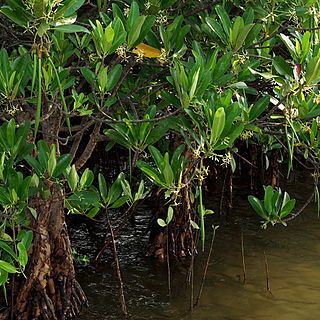Shrub or small tree up to c. 7 m tall. Stem base thickened, generally without proper buttresses. No pneumatophores. Bark smooth, lenticellate, greyish to reddish brown, inner bark thin, pink. Leaves elliptic-oblong to narrowly so, or obovate-oblong, 6-13 by 2.5-6 cm, obtuse, base cuneate, margin usually reflexed; nerves 6-7 pairs, obscure beneath, distinct or slightly elevated above; petiole 1-1.5 cm. Stipules 2 cm long. Inflorescences dichotom-ously branched, 4(-6-9)-flowered, peduncle 1½-5 cm; pedicels 2-3 mm. Flowers white, at anthesis 1½-2 cm long. Bracteoles 2-4, connate, cup-shaped and adnate to the base of the calyx. Calyx tube exceeding the ovary, lobes linear, acute, reflexed after anthesis. Petals c. 14 mm long. Stamens 8-13 mm, filiform. Disk cup-shaped. Ovary 1-celled, with 6 ovules; ovules attached mostly at the apical part of the central axis, pendulous; style filiform, with 3 stigmas. Fruit green, ovoid, 1½-2½ cm long. Hypocotyl clavate, 15-40 cm long, terete, clavate.
More
An evergreen shrub. It grows 1-3 m high. The branches have distinct scars. The leaves are opposite and broadly oval. They are 4-11 cm long by 2-5 cm wide. The flowers are white. They have a half round or cup shaped ring where the petals and sepals join. The sepals are fleshy and the petals bend backwards. They have 2 deep lobes. The fruit are oval and fleshy. They are 1 cm long. There is one viable seed.
A small tree with conically thickened stem base but without buttresses or pneumatophores, sporadic on banks of tidal rivers among other mangroves but almost everywhere scarce and obviously occupying a narrow niche in the mangrove forest, rarely common in association with Sonneratia alba (Batu Lima R., Brunei). In 1939 Steup found Kandelia as pioneer on mud-shoals in the mouth of Indragiri R. (Amphitrite Bay, Mandah courses) fronting Rhizophora.
More
It is a subtropical plant. It grows in shallow waters in the estuaries in Hong Kong. It grows in mangroves.
Occurs locally on banks of tidal rivers among other mangrove species, but is rather rare.


